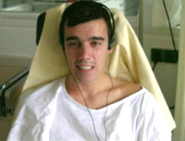Patients Spend Five Days in Coma to Manage Pain
Desperate Patients Undergo Risky Procedure as Last Resort
Dan DeFilippo says he suffered with unbearable pain after a car accident left him with major nerve damage. (ABC Television News)


Dec. 6, 2004 -- Dan DeFilippo overcame what seemed like insurmountable odds when he survived a car crash that killed four of his friends. But while DeFilippo was thankful to be alive, his life had turned into a constant state of torture.
"The types of pain would be sharp, burning pain, achy pain to the extent where a ceiling fan, the breeze on my leg would be excruciating," DeFilippo said on ABC News Good Morning America. DeFilippo's pain was a result of something called RSD, or Reflex Sympathetic Dystrophy, a chronic neurological syndrome characterized by severe burning pain, pathological changes in bone and skin, excessive sweating, tissue swelling, and extreme sensitivity to touch. An injury DeFilippo suffered during the accident brought on RSD, which sent his nervous system out of control and triggered pain signals that were out of proportion to reality.
Dr. Robert Schwartzman, professor and chairman of neurology at the MCP Hahnemann School of Medicine in Philadelphia, has researched RSD for more than 30 years. He says it's important to understand that this is not a psychological condition.
"That injury changes the genetics of the spinal cord," Schwartzman said. "It happens in children and it can happen to anybody. And it is absolutely not psychological." In DeFilippo's case, he says the pain was paralyzing — often sending him into blackouts.
Lindsay Wurtenberg, 14, says her life was turned upside down by RSD after she was bitten by a spider. She ended up with such crippling pain that she needed a wheelchair.
"It just kept getting worse and worse and worse every week," Wurtenberg said.
DeFilippo, of Langhorne, Pa., and Wurtenberg, of Mickletown, N.J., turned to a new treatment, only being offered outside of the United States, when they figured there were no other options left. Both patients traveled to Germany, where doctors used huge amounts of the anesthetic ketamine to put them into a coma for five days. The procedure is not performed in the United States because the Food and Drug Administration does not approve of coma inducement for longer than two days.
Schwartzman, the only American doctor working with the German team, says the anesthetic — when administered for five days — works wonders on RSD patients.
"What we're doing is changing your spinal cord back to normal. The downside is, yes, it's very risky," Schwartzman said. Risks related to the procedure include blood clots in the lungs and infections from catheters.
But Wurtenberg's mother says the risky process gave her daughter her life back. Schwartzman says that while the procedure has helped Wurtenberg and DeFilippo, it hasn't helped every patient with RSD. He says the process only blocks the extreme pain patients experience, but doesn't fix the underlying problem. As a result, the pain associated with RSD can return.
DeFilippo says the procedure has completely changed his life.
"Luckily enough, I was given the opportunity to be able to undergo the treatment and it virtually has changed my life," DeFilippo said. "I was in such a state of agony. My life — quality of life — was nonexistent. Now I have everything looking up for me."
ABC News affiliate WPVI in Philadelphia contributed to the "Good Morning America" report.
Click Here For CNN Report On Ketamine Coma

